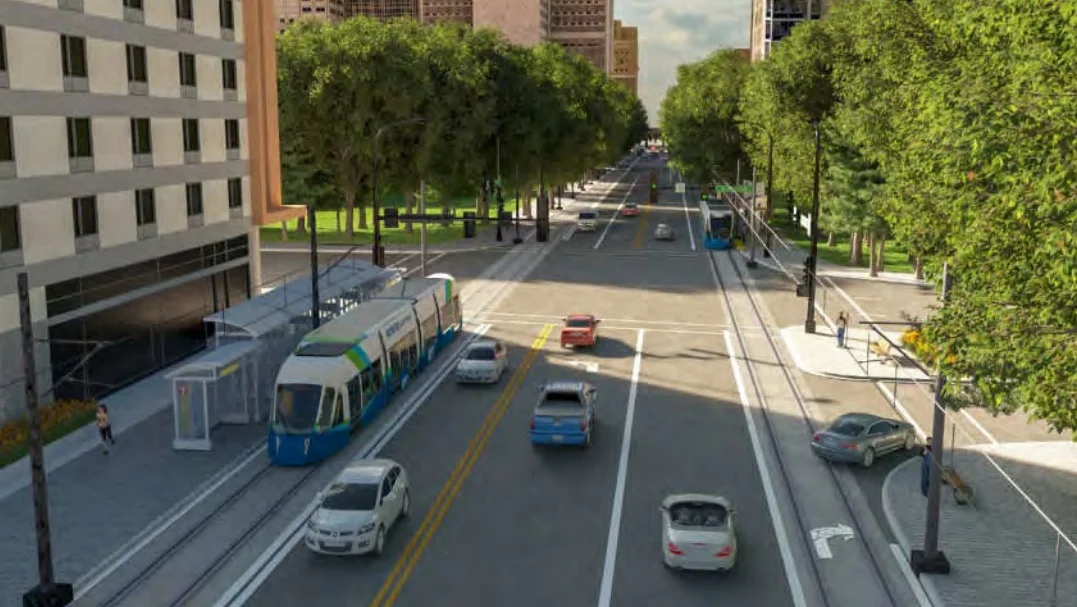DMCC Board chooses rubber over rail, despite opposition from the mayor
In one of the most pivotal actions the body has taken to date, the Destination Medical Center Corporation Board voted Friday in favor of the staff-recommended alternative to use high-speed buses for the planned downtown transit circulator.
The board adopted the motion despite opposition from Mayor Kim Norton, who has been adamant about her preference for a rail system. It marked the first time in the five-year history of DMC that a board member — in this case Norton — has voted against a written resolution.
Discussion on the city’s long-range transit planning now heads to the Rochester City Council, which is set to take up the topic Monday night. By all indications, the council will adopt the bus rapid transit (BRT) option.
As part of that plan, the routes for the circulator will be Broadway Avenue and Second Street Southwest. Those two corridors, according to the DMCC-approved measure, will be anchored by transit villages, a concept that combines parking ramps with other amenities, such as housing and retail. Unlike traditional city buses, the BRT lines are expected to operate every 10 minutes during peak periods and would use their own designated lanes.
“This is more than a bus system,” Patrick Seeb, DMC’s director of economic development and placemaking, told the DMCC board on Friday. “This is a rapid transit system that uses an electric bus vehicle, but has the amenities that would be expected of a high-quality transit system.”
In opposing the BRT option, Norton cited concerns about using designated lanes for buses, which she suggested could increase congestion along the two proposed corridors. The mayor also questioned why other alternatives, such as elevated or underground rail, were not considered.
“For me, I was interested in bringing something to this community with the DMC initiative that was exciting and new and would drive people here,” said Norton, who co-authored the 2013 DMC legislation while a member of the Minnesota House (more on the mayor’s advocacy for rail here).
Norton, however, found herself all alone in advocating for a different direction than the one recommended by city and DMC staff.
R.T. Rybak, the DMCC board chair, said while he initially had thought rail would be the best option, he came around to the BRT alternative after evaluating the dramatic differences in cost and scheduled completion.
According to city estimates, the capital cost of a BRT system is expected to be around $100 million, compared to $360-380 million for streetcars. Local officials have also stated that they believe Rochester would be more competitive in applying for federal funds if they chose the BRT option.
“We gotta do this quickly — not recklessly — but we do have to have a sense of urgency to get ahead of this issue. So, I rather have this done before the very, very long time it takes for rail,” said Rybak, who served as Minneapolis mayor from 2002-2014. “And the other issue is, if you spend less money, that’s a good thing. It means you would have resources left to deal with the experience part, which may be the most important [such as ensuring the on and off points for the transit routes are climate controlled].”
While Rybak and Norton — the two most vocal members of the board — were at odds over whether to move forward with rubber or rail, they did agree that the proposed transit villages should be more than parking.
In conjunction with that conversation, the board ultimately adopted an amendment stipulating that any new development at the two proposed transit villages — to be located at Graham Park/ the former Seneca site and the Mayo West Lot — must include affordable workforce housing.
[If you are playing catch-up on this topic, be sure to check out our previous report here — it’s the second item in the article.]
Sean Baker is a Rochester journalist and the founder of Med City Beat.








